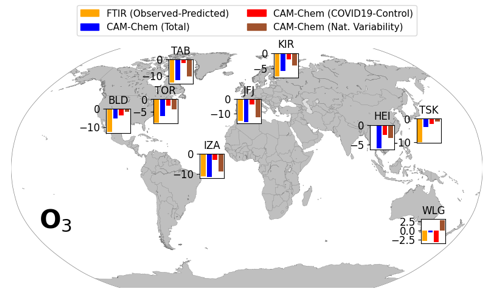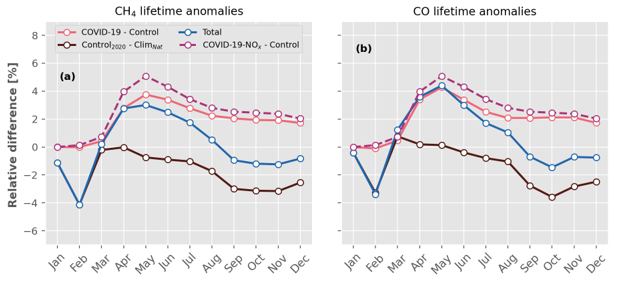The global COVID-19 pandemic and its associated restrictions on human activity presented a unique opportunity to study changes in atmospheric composition. The analysis of the impact of stay-at-home measures on air quality has primarily relied on surface in-situ measurements and satellite platforms. Ortega et al. (2023) showed that ground-based NDACC IRWG observations captured rapid changes in atmospheric composition. In this study, they examined several gases (ozone, CO, C2H2, H2CO, and C2H6) and quantified changes (anomalies) during the most stringent COVID-19 lockdown in 2020 using multiple ground-based FTIRs in both urban and remote air environments. To estimate business-as-usual tropospheric columns of these gases for 2020, they utilized a forecasting method that incorporated trends and inter-annual variability from previous long-term records. By comparing predicted business-as-usual values for 2020 to actual observations, anomalies were calculated for each month. To evaluate these changes, simulations from the global CAM-chem model were used to separate the effects of the COVID-19 restrictions and natural variability for the analyzed gases.
For example, Figure 1 shows a map with ozone anomalies estimated at several sites. The orange bars are FTIR anomalies; the CAM-chem blue bars are the total anomalies estimated from the COVID-19 (red) and natural variability (brown) contributions. All sites show a decline of ozone in the troposphere with a global mean of 9.2 % during March - May 2020. The model accurately captured the magnitudes of observed anomalies, particularly for remote Northern Hemisphere sites where natural variability played a substantial role. CAM-chem simulations suggest that reductions in stratospheric ozone also contributed to the total tropospheric reduction, particularly in locations below the ozone depletion, though other factors are also involved.
The study also examined global CO anomalies using Terra/MOPITT satellite data, showing lower values in North America and Europe in March 2020. However, the absence of further reductions in April and May despite decreased anthropogenic emissions was linked to a negative anomaly in the hydroxyl radical (OH) using model simulations. The analysis highlighted the implications for CH4 lifetime. Figure 2 shows CAM-chem anomalies of the CH4 and CO lifetime during 2020 illustrating chemical losses during this time. Simulations capture a decrease in global tropospheric OH by more than 2%, starting in April and for the rest of the year, and the model estimates net positive anomalies in the lifetimes of CH4 and CO of about 3% due to reductions in emissions during the stringent COVID-19 period (solid pink line). Interestingly, the net anomalies for 2020 (blue line) were nearly neutral for the last 6 months of 2020, because of equally large typical anomalies (brown line). The findings emphasize the complex interplay between natural variability and human activities on atmospheric composition during a global lockdown.
Contact: Ivan Ortega, NCAR, Boulder, CO, USA, iortega@ucar.edu
Ivan Ortega, Gaubert, B., Hannigan, J. W., Brasseur, G., Worden, H. M., Blumenstock, T., Fu, H., Hase, F., Jeseck, P., Jones, N., Liu, C., Mahieu, E., Morino, I., Murata, I., Notholt, J., Palm, M., Röhling, A., Té, Y., Strong, K., Sun, Y., and Yamanouchi, S. (2023). Anomalies of O3, CO, C2H2, H2CO, and C2H6 detected with multiple ground-based Fourier-transform infrared spectrometers and assessed with model simulation in 2020: COVID19 lockdowns versus natural variability. Elementa: Science of the Anthropocene, 11(1). 00015.
https://doi.org/10.1525/elementa.2023.00015

Figure 1. Map illustrating percent tropospheric ozone anomalies 9 NDACC stations, estimated using mean values during March - May 2020. (Note that the exact location of the site may have been moved to include all histograms in the map.)

Figure 2. 2020 monthly percent relative anomalies of the global and tropospheric lifetimes for CH4 (a) and CO (b) from CAM-chem.